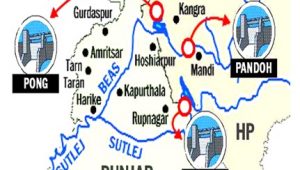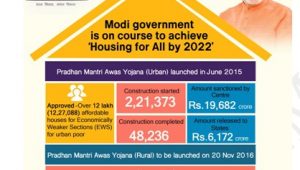
Current Affairs 30 March 2021
- Less than 6% of houses under PMAY-G completed this year
- Ministry of Rural Development.
- Housing for All – The PMAY-G was launched in 2016.
- Aims to provide pucca house with basic amenities to all rural families who are homeless or living in kutcha or dilapidated houses by the end of March 2022.
- The initiative helped in creation of jobs for migrant workers.
- PMAY – Pradhan Mantri Awaas Yojana
- The erstwhile rural housing scheme Indira Awaas Yojana (IAY) has been restructured into Pradhan Mantri Awaas Yojana – Gramin (PMAY-G).
- Cost Sharing: The cost of unit assistance in this scheme is shared between Central and State governments in the ration 60:40 in plain areas and 90:10 for North Eastern and Himalayan States.
- The scheme envisages training of Rural Masons with the objective of improving workmanship and quality of construction of houses while at the same time, increasing availability of skilled masons and enhancing employability of such masons.
- Selection of beneficiaries under Pradhan Mantri Awaas Yojana – Gramin is based on housing deprivation parameters of Socio-Economic and Caste Census (SECC), 2011, subject to 13 point exclusion criteria, followed by Gram Sabha verification.

- Socio-Economic and Caste Census (SECC)
- SECC was conducted for the first time in 1931
- SECC is meant to canvass every Indian family, both in rural and urban India, and ask about their:
- Economic status, so as to allow Central and State authorities to come up with a range of indicators of deprivation, permutations and combinations of which could be used by each authority to define a poor or deprived person.
- It is also meant to ask every person their specific caste name to allow the government to re-evaluate which caste groups were economically worst off and which were better off.
- Difference between Census and SECC
- The Census provides a portrait of the Indian population, while the SECC is a tool to identify beneficiaries of state support.
- Since the Census falls under the Census Act of 1948, all data are considered confidential, whereas according to the SECC website, “all the personal information given in SECC is open for use by Government departments to grant and/or restrict benefits to households”.
- SC lays down time frame for accident information reports
- The Supreme Court has directed police stations to send accident information reports to Motor Accident Claims Tribunal and insurers within 48 hours of a road accident.
- The jurisdictional police station shall report the accident under section 158(6) of the Motor Vehicle Act (Section 159 post 2019 amendment) to the tribunal and insurer within first 48 hours either over email or a dedicated website.
- This is to prevent delays in disbursement of compensations to victims
- SC also ordered the centre to launch a national online platform, which could be accessed across the country for submission of accident reports, claims, and responses to claims, etc.
- This would end the distress felt by victims when accidents happened in places other than their native state.
- WHO report says animals are likely source of COVID-19
- A joint WHO-China study on the origins of COVID-19 says that transmission of the virus from bats to humans through animal is the most likely scenario and the lab leak is “extremely unlikely,”.
- The report is based largely on a visit by a WHO team of international experts to Wuhan.
- This possibility of spreading virus from bats to humans through animal was previously dismissed by the WHO and the U.S. Centers for Disease Control and Prevention, but researchers on this mission have taken it up again.
- Bats are known to carry corona viruses and, in fact, the closest relative of the virus that causes COVID-19 has been found in bats.
- Similar viruses are also found in pangolins, but scientists have yet to identify the same corona virus in animals that has been infecting humans.
Current Affairs 30 March 2021












